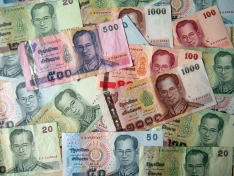Trading Guide to Thai Baht
The Thai Baht is one of South East Asia’s most important currencies thanks to Thailand’s prominence as one of the most stable regional economies, its status as a global tourist destination, and its place as an origin for important manufacturing and agricultural exports. The Thai Baht has the symbol ฿, and it is represented by the Forex currency code THB. Every day, around US$1.6 billion Baht are traded on the Forex market, and there are around ฿1.455 trillion in total circulation. The Bank of Thailand is the country’s central bank, and this body has the power to regulate the currency and issue banknotes and coins. The Bank of Thailand is also responsible for setting monetary policy, with the nation’s interest rates being set by the seven members of the central bank’s monetary policy committee. For the last 16 years, the central bank has followed a policy of inflation-targeting in an attempt to maintain financial stability and achieve sustainable economic growth. Monetary Policy Committee meetings are held eight times a year at 6-weekly intervals during which annual inflation targets are set based on global monetary policies, global economic data, world oil prices and world commodity prices. The Thai Baht is traded in many different currency pairings on the Forex market, including primary world currencies and Asian regional currencies. These include the US Dollar, the Australian Dollar, the Euro, the Pound Sterling and the Japanese Yen. Although it is regarded as an exotic currency, it still attracts considerable interest among investors. As the Thai economy is relatively stable, the Baht is accepted widely throughout the South East Asian region, and in particular in the neighbouring countries of Cambodia, Laos, Malaysia, Vietnam and Myanmar. The Baht Economic Zone is a name given to a government policy, begun in the 1990s, to promote expanded interchange with other nations in the region. In the future, its influence could widen to include other key trade partners in the region, such as Indonesia and the Philippines.
| Broker | Bonus | More |
|---|
The History of the Thai Baht

The Economy of Thailand
Thailand is a relatively recently industrialised country, with an economy that is heavily dependent upon exports. Exports account for over two thirds of the nation’s GDP, and the service and industrial sectors are the primary sectors that make up the Thai gross domestic product. The country’s communication, logistics and trade sectors make up a large portion of the nation’s economy, with agriculture, tourism, finance and education also being important. The telecommunications sector is also beginning to emerge as an area of economic competitiveness and industrial expansion. Major trading partners include the United States, Japan, Malaysia and China. The tourist industry is also essential to Thailand’s economy, with Bangkok and the country’s beach resorts being very popular with overseas visitors. In recent years, the economy of Thailand has seen a slowdown in growth due to a weakened global demand and political turmoil in the country. Despite this, the government has been able to maintain low levels of inflation and has kept the currency stable, having negotiated free trade agreements with several countries including New Zealand, Japan, India, China and Australia.
Factors That Influence Thailand’s Economy
Thailand’s economic health is largely dependent upon global demand for its export products. Political instability in the region also has a role to play in determining the value of the Thai Baht, as when there is volatility in the country, for example during the 2014 coup, international uncertainty about the nation’s economic and political situation led to a decrease in consumer confidence, and therefore a lower value for the currency. Political unrest also leads to a decline in global tourism, one of the key factors in determining the health of Thailand’s economy. Fewer tourists means less income, and so the country’s GDP takes a hit. China is one of Thailand’s primary trading partners, and therefore any issues that affect the Chinese economy will also impact on the economy of Thailand in turn.


